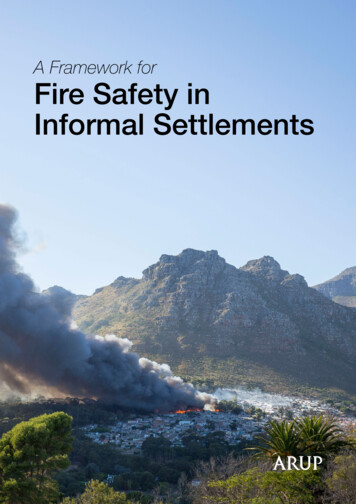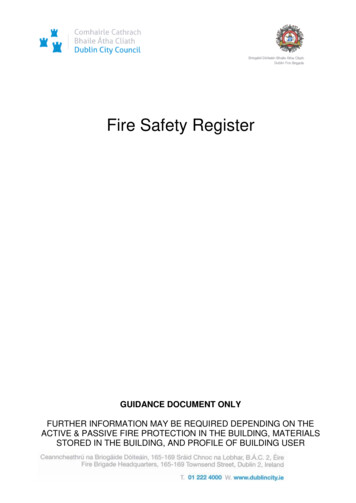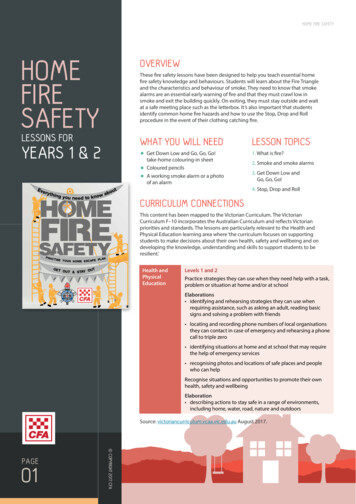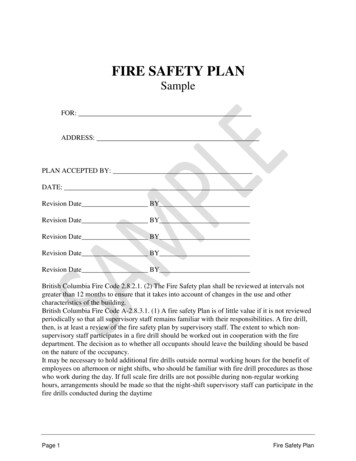
Transcription
A Framework forFire Safety inInformal Settlements
ForewordContentsThree years ago, we set out to understand the natureand scale of fires in informal settlements. Our objectivewas to identify risks and points of intervention to improvefire safety. We quickly realised there is a gap in firesafety knowledge, experience, assessment tools andconstruction guidance for informal settlements.Foreword.03Introduction.05We also acknowledged the need for a common languagearound fire safety in informal settlements. Within theprofessional fire safety community, attentions arecommonly focused on the formal built environment, to theneglect of informal communities. Amongst stakeholdersworking to support informal settlements, fire is oftenrecognised as a significant risk. However, in the absenceof practical tried and trusted solutions, fire risk reductionis seldom given the investment it requires. We, thereforedeveloped this Framework for Fire Safety in InformalSettlements to facilitate collaboration and alignment ofglobal efforts to create safer and more resilient informalsettlement communities.What is the framework?.06Understanding fire safety.08Structure of the 6Recovery.18International insights.20This framework is an initial step. With it, we aim tomotivate investments in fire safety by providing a wayfor stakeholders to engage with the issues. We arealso exploring opportunities to develop robust, holisticand accessible tools that empower communities andorganisations to assess fire risks and prioritise fire riskreduction efforts and investments. Generally, thereis a need to consider fire within holistic strategies forthe resilience of communities and cities in the face ofmultiple hazards. As such, we hope that this frameworkwill also support the incorporation of fire safety withinwider disaster planning.Research behind the framework.24Next steps.25October 2018Dr Barbara Lane FREng FRSE CEngArup Fellow, Fire Safety EngineeringMember, UKIMEA Board and Arup University CouncilJo da Silva, Director and Arup FellowLeader of Arup International Development Arup 2018arup.com/services/fire2A Framework for Fire Safety in Informal Settlements ArupArup A Framework for Fire Safety in Informal Settlements3
Fire in Imizamo Yethu informal settlement, 11thMarch 2017, Cape Town, South AfricaPhoto credit: Bruce Sutherland City of Cape TownIntroductionA fire in an informal settlement can affectthousands of people. Fires take lives, causeserious injuries, destroy property and have longterm impacts on livelihoods. Recovery is a longand difficult process, which can be exacerbatedin informal settlements where financial instability,insecure tenure and a lack of insurance arecommon. But this global fire problem remainslargely neglected.Limited resources and a myriad of competingneeds and risks inhibit communities’ ability toimprove fire safety. Where resources are devotedto fire safety, investments are seldom informed bya holistic consideration of fire risk and potentialrisk reduction options. Local fire safety lessonslearned and success stories are also rarelyshared between settlements, let alone acrossborders.Fire events in informal settlements are rarelyreported in international media, even when theyamount to major community-wide disasters.Moreover, there are too few investments in fire riskreduction for informal settlements globally.It is time to empower communities with fire safetyknowledge, resources, and support so that theycan become resilient to fire. This framework is aninitial step towards facilitating this movement.Fires cause over 130,000 deathsglobally per year. This is more thandouble the annual average deathsdue to natural disasters.1In 2016, approximately one fifthof the world’s population live inlow/low-middle SDI countries.However, almost half of the world’sdeaths due to fire occur in thesecountries.2Informal settlements are unplanned and often densely-populated residential areas where inhabitantsmay lack security of tenure, have poor-quality housing, limited supporting infrastructure, and services(including health care and emergency services) and high vulnerability to fires and other hazards. Informalsettlements include slums, refugee camps and internally displaced persons’ camps. One billion peoplelive in informal settlements today.3Socio-demographic index (SDI) is a summary measure that identifies where countries or othergeographic areas sit on the spectrum of development. Expressed on a scale of 0 to 1, SDI is a compositeaverage of the rankings of the incomes per capita, average educational attainment, and fertility rates of allareas in the Global Burden of Disease (GBD) study.414A Framework for Fire Safety in Informal Settlements ArupBetween 2000 and 2016. Retrieved from Our World in Data (https://ourworldindata.org) on 14th September 2018.2Retrieved from Our World in Data (https://ourworldindata.org) on 14th September 2018.3“Slum Almanac 2015/2016, Tracking Improvement in the Lives of Slum Dwellers,” Participatory Slum Upgrading Programme Team Nairobi,Nairobi, 2016.4Retrieved from Institute for Health Metrics and Evaluation -demographic-index-sd) on 19thSeptember 2018.Arup A Framework for Fire Safety in Informal Settlements5
What is the framework?Fire risk in informal settlements is a multi-facetedproblem. It is framed by a variety of underlyingsocio-cultural, economic and political factors,and is comprised of many different aspects, atscales ranging from the household to the nationalgovernment. Improving fire safety in informalsettlements is, therefore, a complex challenge.The framework provides a structured wayof approaching the challenge and supportsconsideration of fire risk reduction. It has beendeveloped to be flexible so that it can be appliedto different contexts and settlement typologies. Werecommend using the framework in conjunctionwith analysis of the local context, in order tounderstand the unique and often complexdynamics of a particular informal settlement.Stakeholder mapping should be undertaken toidentify community groups and organisationswhich may influence, support, or implementactions to improve fire safety.This framework does not seek to evaluate orquantify fire hazards or safety measures. It isintended as the first step in the development oftools to assess fire risk in informal settlements andtarget effective and efficient investments in fire riskreduction.We hope that this framework will be a pointof reference for a wide range of stakeholdersseeking to better understand fire safety in informalsettlements. For a particular informal settlement,the framework could be used to support aholistic consideration of fire risk and potential riskreduction options.Examples of the anticipated users of thisframework include:- Non-governmental organisations (NGOs)- Community groups- Fire and rescue services- Researchers and practitioners working on thesubject- Public or private sector investors- Government bodiesCox’s Bazar refugee camp Bangladesh European Union 20186A Framework for Fire Safety in Informal Settlements ArupArup A Framework for Fire Safety in Informal Settlements7
Understanding fire safetyWhat are we trying to achieve?The performance objectives for fire safety in the builtenvironment focus on protecting life whilst minimisingthe effects of fire on livelihoods, property and theenvironment. The fundamental principles consider thefollowing:- Alerting people to the presence of fire- Providing suitable routes for evacuation, including forpersons who require assistance to escape- Reducing the potential for rapid fire spread so thatescape is not inhibited- Limiting fire size to enable evacuation, firefightingand rescue operations, and to minimise damage toproperty- Protecting structural elements to prevent premature ordisproportionate collapse- Preventing fire spread to other buildings andsurrounding urban infrastructure- Providing access routes and facilities to supportfirefighting and rescue operationsThe evolution of fire safetyFire safety considerations for the built environment haveevolved over time, through lessons learned from majorfire events and the development of fire safety science.For example, following the Great Fire of London in 1666,in which over 13,000 houses were destroyed, a new,more fire-conscious approach to urban development wasadopted to prevent such an event from occurring again.The early fire brigade was born, London streets werewidened and restrictions on the use of wood and thatchin favour of less combustible materials, such as brick andstone, were established.8Photo credit: Sullivan PhotographyIn the past century, fire safety science has advancedsignificantly. Across the world, research has beenundertaken on a wide range of topics, including firedevelopment, smoke movement, heat transfer, theresponse of building materials and structures to fire,and human behaviour in the event of a fire. Codes andstandards have been developed to share knowledge andbest practices. They continue to evolve as lessons arelearned from further fire events, as well as from appliedand fundamental research. Combinations of fire safetymeasures are typically proposed as part of a layeredfire safety approach, commensurate with the risks andcharacteristics associated with a particular component ofthe built environment.Fire safety in informal settlementsIn informal settlements, factors such as the high densityof buildings and the use of combustible constructionmaterials can cause fire spread to be rapid. Promptevacuation and firefighting intervention are thereforecritical to protect life, minimise property damage and limitthe impacts on livelihoods.Communities that are resilient to fire can withstand,respond to and recover from severe fire incidents,thereby contributing to residents’ broader wellbeingand long-term development. This requires actionthroughout the entirety of the disaster management cycle– mitigation, preparedness, response, and recovery.Improvements in fire safety may be realised throughdirect investments in fire risk reduction or as co-benefitsfrom investments in informal settlements more broadly.The most effective investments will require a holisticconsideration of the physical and social nature of fire riskand fire safety.A Framework for Fire Safety in Informal Settlements ArupFire safetyconsiderations forinformal settlementsmust be holisticand take accountof the wide range ofcompeting risks andchallenges, whichare often unique tolocal context.Arup A Framework for Fire Safety in Informal Settlements9
Structure of the frameworkThe framework links the key considerations for fire safetyin informal settlements. Underlying contextual factorsare placed at its centre, emphasising their universal andconstant relevance to all strands of the topic.The framework is organised around the four stages ofthe disaster cycle and identifies twelve key aspects offire safety. The rings represent the different scales atwhich action to improve fire safety should be considered(household, community, city).Further discussion on the aspects most relevant to eachof the disaster cycle stages is provided in the followingpages, highlighting key challenges and providingpractical examples of how fire risk can be reduced atdifferent scales.ContextThe disaster cycleThere are a wide variety of drivers that lead tothe development of informal settlements (e.g.economic migration, conflict, disasters), which canbe formed as emergency settlements, transitionalsettlements, or permanent settlements.Commonly used in the context of natural disasterssuch as flooding, storms, earthquakes, landslides,and wildfires, the disaster cycle may also be appliedto fires in informal settlements, which are oftencommunity-scale disasters. The disaster cyclehas four key stages, any of which may be usedas a starting point for considering vulnerability orresilience:Fire risk in informal settlements must be consideredalongside other shocks and stresses and in light ofcompeting constraints and objectives.There are a range of underlying contextual factors,which compound disaster vulnerability withininformal settlements. The factors can be broadlycategorised as follows:Socio-cultural – including demographics, culturalbeliefs about fire, attitudes towards risk andsocietal cohesion.Economic – vulnerabilities brought about or framedby economic limitations and a variety of immediatedaily challenges (e.g. access to food, healthcare,education).Political – relationships between stakeholders andthe political will of a local government to supportinvestments in safety and resilience of informalsettlements.Response – actions taken during a fire incident tosave lives, protect property and critical infrastructure.Recovery – actions taken in the aftermath of a fireincident, both immediately to assist with healthcareand welfare, and longer-term to return communitiesto normal life and bring about improvements in firesafety.ScalesThe framework identifies twelve aspects of firesafety – three aspects for each stage of the disastercycle. Their importance overall, and in relation toeach other, will depend on the specific context ofeach informal settlement. In practice, these aspectsmay also be relevant for more than one stage.The disaster cycle stages and fire safety aspectscan be considered at different scales, andby stakeholders at each of these scales. Theframework considers three scales:dityunit ymCmHousehold – an individual or a group of people(e.g. a family) living in a single dwelling.Community – a group of households living ina close geographical area, having a particularcharacteristic in common.olehsouCoA Framework for Fire Safety in Informal Settlements ArupPreparedness – strategies, procedures, resourcesand training that influence and inform stakeholders’fire response and recovery.AspectsH10Mitigation – measures to prevent or reduce thelikelihood, severity, and consequences of fire.Arup A Framework for Fire Safety in Informal SettlementsCity – a place where people gather, either bychoice or by circumstance.The interactions and relationships betweenstakeholders at each scale, and across scales, hasa significant bearing on fire safety.11
MitigationMitigation measures should be based on the fire risksin each specific informal settlement. Effective mitigationmeasures can prevent or reduce the likelihood, severity,and consequences of fires. The key aspects to considerwhen developing fire mitigation measures are the NaturalEnvironment, Built Environment, and Causes & Catalysts.Investments in mitigation are generally a cost-effectiveuse of fire risk reduction resources. Where possible,investments in mitigation should draw on lessons learnedfrom previous fires.HouseholdNatural EnvironmentBuilt EnvironmentCauses & CatalystsFire risk can be greatly influencedby natural conditions. For example,arid and hot climates presentadditional risks over wetter andcooler environments in terms ofignition and readily burnable fuelsources (e.g. dry vegetation).Informal settlements built at theWildland-Urban Interface (i.e.where homes are built near oramong lands prone to wildlandfire) have an increased firerisk. Weather and topographycan influence fire behaviour,particularly the direction and rateof fire spread. Fire spread couldbe exacerbated by strong windsor the position of settlementson hillsides or sloping sites.Other natural disasters, such asflooding, can impact fire escaperoutes or firefighting accessroutes, increasing a community’svulnerability to fire.Construction typologies of informalsettlements vary widely dependingon the local context and availabilityof suitable construction materials.Combustible construction materials(e.g. timber) and linings (e.g.plastic sheeting) can increaseboth the likelihood and severity offires. Poor building stability canexacerbate fire spread throughan informal settlement. Limitedspace is a common issue ininformal settlements, resultingin minimal separation distancesbetween dwellings. Fire spreadbetween dwellings and throughentire settlements is thereforecommon. Limited access throughsettlements is also commoncausing significant challenges withevacuation and firefighting.The cause of a fire is the way afire physically starts (e.g. ignitionsource). Human behaviours thatmay influence the likelihood orseverity of fire are consideredcatalysts to fire risk. Fires ininformal settlements are mostcommonly caused by open flamesources (for cooking, heating, andlighting) and overloaded or poorlymaintained (and often illegal)electrical connections. Fire riskmay change with seasons. Forexample, an increased relianceon heating devices during coldseasons can increase fire risk.Examples of catalysts includechildren playing with fire, alcoholintoxication and smoking. Firesafety training can help createawareness of the risks associatedwith these types of behavioursand activities (see Preparedness).The above description of catalystsrelates to accidental fires. Arson,the human act of maliciously anddeliberately starting a fire is, infact, a cause of fire.----------Remove dry vegetation fromaround and between dwellingsAvoid building in areas whereaccess for firefighting vehiclesmay be challenging, such as inareas prone to floodingAvoid building on steephillsides, where fire may spreadrapidly upwards---Use construction materials(structure and linings) which donot propagate rapid fire growth(e.g. avoid plastic sheet wallsand roof coverings)Provide multiple escape routesfrom each dwellingMaximise separation distanceto adjacent dwellings------Community------City12A Framework for Fire Safety in Informal Settlements Arup--Manage vegetation atsettlement boundaryAvoid settlement developmentin naturally hazardousareas, such as wetlands andfloodplains of riversLocate vulnerable or criticalbuildings (e.g. schools, clinics,community centres) in upwindor less hazardous areas--Implement wildland firemanagement policies andstrategies to help prevent firespread to informal settlementsImprove wildland firefightingresponse to help prevent firespread to informal settlements--Arup A Framework for Fire Safety in Informal Settlements-------Replace open flame cooking,lighting and heating applianceswith safer alternativesPractice safe storage of fuelsused for cooking, lighting, andheatingUse surge protectors, circuitbreakers, insulated electricalwiring and equipment withfusesStore waste safely and removewaste regularlyEstablish and maintain firebreaks, evacuation routes, andvehicle access routesMaximise separation distancebetween dwellings andminimise density of dwellingsAvoid settlement developmentnear high hazard areas, suchas landfills and industrialpremises--Organise refuse collectionservices where not officiallyprovidedImplement policies relating toland tenure and land useImplement policies that allowfor upgrading of informalsettlements and the use ofrobust building materialsCommit to city planning whichpromotes and supports theuse of appropriate buildingmaterials and fire safetyprinciples for dwelling andsettlement design----Provide safe electricityProvide refuse collectionSubsidize cost of safer cooking,lighting and heating appliancesand/or promote market-drivendistribution to communitiesImplement standards for safercooking, lighting and heatingappliances and enforceregulations to help preventunsafe appliances entering themarketplace--13
PreparednessPreparedness includes the strategies, procedures,resources, and training that influence and informstakeholders’ fire response and recovery. Preparednessstrategies should leverage resources, organisationalstructures, and capacities of communities and relevantstakeholders. The main aspects to consider duringpreparedness in informal settlements are Organisation& Planning, Awareness & Training, and Fire SafetyResources.HouseholdOrganisation & PlanningAwareness & TrainingFire Safety ResourcesRoles and responsibilities ofcommunities, local organisations,fire and rescue services, and otherstakeholders should be clearlydefined to enable an effectivefire response and recovery.Coordination minimises duplicationof efforts and ensures stakeholderswork together to achieve commongoals, namely to save lives,protect property and livelihoods,and return communities to normallife as soon as possible. Firesafety management plans thatare ‘owned’ by communities andsupported by other stakeholderscan be both cost-effective andsustainable. By empoweringcommunities, local knowledgeand expertise can be leveraged,responsibilities of communitymembers can be establishedand technical and organisationalcapacities can be strengthened.The perception of fire riskinfluences stakeholders’behaviours with respect to firesafety, including their tendencyto invest in fire mitigation andpreparedness measures. Firerisk perception is influencedby a multitude of factors, suchas past experiences with fire,culture, competing risks, andimmediate needs. Fire safetyawareness campaigns andtraining can empower individualsand communities to identifyhazards in their own communityand take action to improve firesafety. Organisations supportingcommunities should coordinatetheir efforts to deliver consistentfire safety messages andstandardised training programmes,potentially targeted towardsspecific groups (e.g. child-friendly,gender specific). Fire responseteams (e.g. community firefightingteams, fire and rescue services)should coordinate their trainingand response structure to thespecific challenges of informalsettlement fires.The ability of stakeholders torespond effectively to a fireis highly dependent on theavailability of fire safety resources.Ideally, each household shouldhave a device that warns them of afire (e.g. smoke alarm) and accessto firefighting equipment (e.g. fireblanket or bucket of sand) so theycan extinguish the fire early. Firesthat spread beyond the dwellingof origin can pose significantchallenges, emphasising theimportance of personal protectiveequipment to protect firefighters.Appropriate emergency vehicles,firefighting equipment and tools,and a reliable water supply (e.g.hydrants) can help improve fireresponse. Alternate extinguishingagents are needed where wateris not appropriate (e.g. electricalor oil-based fires). Provisions forpersons who require assistanceto escape during a fire should beconsidered (e.g. accessible egressroutes).--Develop an evacuation planand practice it in advanceMemorise emergency servicesphone number(s), save tophone contacts and keep awritten recordNotify neighbours, communityfirefighting teams and otherresponse organisations (e.g.fire and rescue services) ofassistance needed to escapeduring a fire--Identify household fire hazards(and develop appropriate riskmitigation measures)Use safe cooking, lighting andheating practice (e.g. do notleave appliances unattended,keep clothing/furniture awayfrom appliances, etc.)Share knowledge and ideaswith neighboursTeach children about fire safetyand promote safe behaviour--Make a community fireresponse planCoordinate fire response planwith other stakeholdersSupport the developmentof personal emergencyevacuation plans for personsrequiring assistance to escapeEstablish a communityfirefighting team and developcommunity firefightingprocedures--Identify ‘community level’fire hazards (e.g. electricalwiring, burning of waste,cooking fuel storage – LPG,wood, kerosene, etc.) anddevelop appropriate mitigationmeasures to reduce communityfire riskCoordinate training andawareness sessions on fire riskand fire safety---Support community fireresponse planning andcoordinationDevelop procedures to shut offelectricity supply during a fireAllocate funding and developpolicies and plans to supportthe community after a fire--Deliver fire safety awarenesscampaigns and training forindividual households and thewider communityProvide firefighting trainingfor fire response teams (e.g.community firefighting teams,fire and rescue services) that isspecific to informal settlementsand consistent with thecoordinated fire response planbetween stakeholders--------Community-------City---14A Framework for Fire Safety in Informal Settlements ArupArup A Framework for Fire Safety in Informal Settlements-------------------Device to detect fire and warnresidents (e.g. smoke alarm)Firefighting equipment, such asbuckets of sand or water, potcovers, fire blanketsEvacuation aids for personswho require assistance toescapeCommunity warning systemsCommunity firefightingequipment including personalprotective equipment, fireextinguishers, firefighting tools(e.g. crow bar, beater, hook,axe)Community water tapsProvide emergency vehiclesthat can access (and supply/pump water to) informalsettlements (e.g. 4x4s, firemotorcycles)Provide firefighting equipmentfor fire and rescue services(e.g. personal protectiveequipment, hoses, axes)Install fire hydrants withsuitable hose connectionsProvide local water reservoirsfor firefighting15
ResponseA fire in an informal settlement can spread rapidly andaffect thousands of people. Coordination between thecommunity, emergency services and other stakeholderscan significantly improve fire response. The key actionsduring a fire are Communications, Evacuation, andFirefighting. An effective response can reduce the loss oflife, property damage, the impact on livelihoods and theeffort, time and investment required to return the affectedcommunity to normal ffective communication is criticalduring an informal settlementfire. There are a wide rangeof emergency communicationsystems found in informalsettlements, from residentsusing verbal alarms (shouting“fire”) to hand-cranked alarmsand text-message systems thatwarn the affected community.Communication systems thataddress the needs of deaf/hardof hearing people are beneficial.Mobile phones are prevalentin many informal settlementsaround the world and can beused to activate fire responseteams (e.g. community firefightingteams, fire and rescue services).However, potential challenges withmobile phone battery charging,phone credit and awareness ofemergency phone numbers shouldbe considered. Also the complexityof local or national emergencycommunication systems varies,which can affect the response timeof emergency services.The potential for rapid fire spreadand unstable structures in informalsettlements makes promptevacuation crucial. However,insufficient provisions for evacuationare common in informal settlements.Delays in fire detection and warningcan cause a loss of critical time forsafe evacuation; this is especiallycommon when residents aresleeping. Dwellings with one narrowescape route leave residents with noalternative way out if the single exitis blocked by fire or smoke. Personsrequiring assisted evacuation areparticularly vulnerable if others arenot aware of their needs. It is notuncommon for residents to return totheir homes to save their belongings(e.g. furniture) during a fire. Thisputs their lives in danger and caninterfere with others’ evacuation,firefighting and rescue operations.Residents who evacuate to anassembly point need to maintainawareness of the potential dangersas fires in informal settlements canbe extensive and unpredictabledue to the scale and nature of thesettlement.If a fire is detected early, there maybe an opportunity to extinguishit using simple equipment suchas a bucket of sand or water.However, as a fire grows, sodoes the risk and complexity offirefighting operations. While aspontaneous firefighting responsemay be formed by the community(e.g. bucket brigades), organisedcommunity firefighting teamscan be much more effective(see Preparedness). In someinstances, wildfire tactics mayprove useful, such as creating firebreaks by deliberately knockingdown dwellings to remove fueland prevent further fire spreadacross the settlement. Significantchallenges with emergencyvehicles getting to the fire locationare common due in part toinaccurate fire location reporting,traffic congestion and narrowstreets. A lack of suitable watersupply for firefighting is alsocommon.--Alert children and familymembers of a fireAlert neighbours of a fireActivate community warningsystemAlert community fire responseteams (e.g. communityfirefighting teams, fire andrescue services) as percommunity response plan--Assist children and familymembers who need supportevacuating and leave dwellingimmediatelyWalk to assembly point viaevacuations routesNotify fire response teams ofpersons requiring rescueDo not return to dwelling untilfirefighters confirm it is safe todo so--Communicate accuratelocation of fire and informationrelevant to persons whorequire assistance to escape tocommunity fire response teamsAlert neighbouringcommunities of fire--Notify fire response teams ofpersons requiring rescueImplement a method ofchecking in at assembly pointto monitor who has/has notescapedSupport persons requiringassistance to escape (if theynot able to self-evacuate)--Community firefighting teamscan try to extinguish fires wherethey have appropriate firesafety resources and trainingappropriate for the specific fireincident (see Preparedness)Activate fire and rescueoperati
settlements include slums, refugee camps and internally displaced persons' camps. One billion people live in informal settlements today.3 Socio-demographic index (SDI) is a summary measure that identifies where countries or other geographic areas sit on the spectrum of development. Expressed on a scale of 0 to 1, SDI is a composite











